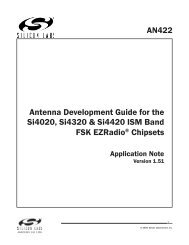C8051F326/7 - Silicon Labs
C8051F326/7 - Silicon Labs
C8051F326/7 - Silicon Labs
You also want an ePaper? Increase the reach of your titles
YUMPU automatically turns print PDFs into web optimized ePapers that Google loves.
1.1. CIP-51 Microcontroller Core<br />
1.1.1. Fully 8051 Compatible<br />
<strong>C8051F326</strong>/7<br />
The <strong>C8051F326</strong>/7 family utilizes <strong>Silicon</strong> Laboratories' proprietary CIP-51 microcontroller core. The CIP-51<br />
is fully compatible with the MCS-51 instruction set; standard 803x/805x assemblers and compilers can<br />
be used to develop software. The CIP-51 core offers all the peripherals included with a standard 8052,<br />
including two 16-bit counter/timers, a full-duplex UART with extended baud rate configuration, 1536 bytes<br />
of on-chip RAM, 128 byte Special Function Register (SFR) address space, and 15 I/O pins.<br />
1.1.2. Improved Throughput<br />
The CIP-51 employs a pipelined architecture that greatly increases its instruction throughput over the standard<br />
8051 architecture. In a standard 8051, all instructions except for MUL and DIV take 12 or 24 system<br />
clock cycles to execute with a maximum system clock of 12-to-24 MHz. By contrast, the CIP-51 core executes<br />
70% of its instructions in one or two system clock cycles, with only four instructions taking more than<br />
four system clock cycles.<br />
The CIP-51 has a total of 109 instructions. The table below shows the total number of instructions that<br />
require each execution time.<br />
Clocks to Execute 1 2 2/3 3 3/4 4 4/5 5 8<br />
Number of Instructions 26 50 5 14 7 3 1 2 1<br />
With the CIP-51's maximum system clock at 25 MHz, it has a peak throughput of 25 MIPS. Figure 1.5<br />
shows a comparison of peak throughputs for various 8-bit microcontroller cores with their maximum system<br />
clocks.<br />
MIPS<br />
25<br />
20<br />
15<br />
10<br />
5<br />
<strong>Silicon</strong> <strong>Labs</strong><br />
CIP-51<br />
(25 MHz clk)<br />
Microchip<br />
PIC17C75x<br />
(33 MHz clk)<br />
Philips<br />
80C51<br />
(33 MHz clk)<br />
ADuC812<br />
8051<br />
(16 MHz clk)<br />
Figure 1.5. Comparison of Peak MCU Execution Speeds<br />
Rev. 1.1 17


